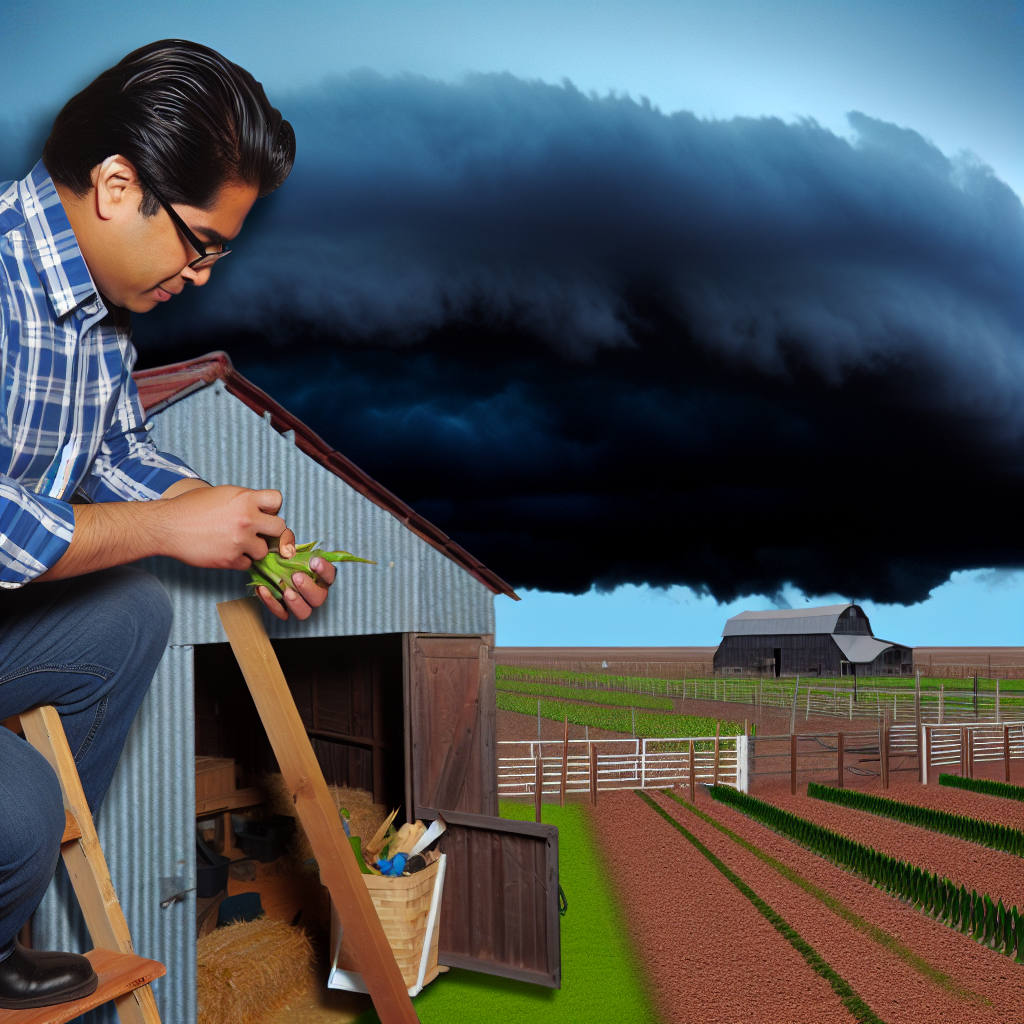Disaster Preparedness for Farmers
Disaster preparedness is crucial for farmers to protect their livelihoods.
Natural disasters can strike at any time, causing severe damage.
By planning ahead, farmers can minimize risks and losses.
Understanding Common Agricultural Disasters
Farmers face a range of disasters that can impact their operations.
These include droughts, floods, hurricanes, and pests.
Each disaster presents unique challenges and requires specific strategies.
Risk Assessment and Management
Performing a risk assessment is the first step in preparedness.
Farmers should identify potential threats to their property and crops.
Next, they should evaluate the likelihood and potential impact of each risk.
Strategically managing these risks involves implementing preventive measures.
Farmers can consider diversifying crops to reduce vulnerability.
Emergency Response Plans
Creating an effective emergency response plan is crucial.
The plan should detail steps to take before, during, and after a disaster.
Farmers can include checklists and evacuation routes in their documents.
Regular drills can help ensure that everyone knows their roles.
Transform Your Agribusiness
Unlock your farm's potential with expert advice tailored to your needs. Get actionable steps that drive real results.
Get StartedInsurance Options for Farmers
Insurance plays a vital role in disaster preparedness.
Farmers should explore different types of insurance available to them.
Crop insurance protects against losses due to natural disasters.
Liability insurance helps farmers manage risks related to accidents or injuries.
Evaluating coverage options helps farmers choose the best policies for their needs.
Community Support and Resources
Local resources can significantly aid disaster preparedness efforts.
Farmers should engage with local agricultural extension services.
These services offer valuable information on disaster recovery and management.
Forming networks with other farmers can provide additional support.
Sharing resources and experiences can strengthen community resilience.
Types of Natural Disasters Affecting Agriculture
Severe Weather Events
Severe weather events pose significant risks to farmers.
Strong storms can lead to flooding and soil erosion.
Heavy rainfall often damages crops and infrastructure.
Additionally, hailstorms can destroy fruit and vulnerable plants.
Drought
Drought conditions can devastate agricultural production.
Lack of water stresses crops, leading to lower yields.
Farmers face economic losses due to diminished harvests.
Moreover, droughts affect soil health and fertility.
Wildfires
Wildfires pose a growing threat to agricultural lands.
These fires can destroy crops and pasturelands quickly.
Smoke and soot negatively impact air quality for livestock.
Consequently, farmers may experience losses in revenue.
Floods
Flooding is a major concern after heavy rainfall or hurricanes.
Excess water can drown crops and displace livestock.
Showcase Your Farming Business
Publish your professional farming services profile on our blog for a one-time fee of $200 and reach a dedicated audience of farmers and agribusiness owners.
Publish Your ProfileFloods also lead to soil degradation and nutrient loss.
Farmers often need to invest in recovery efforts post-flood.
Pests and Diseases
Pests and diseases can emerge unexpectedly, threatening crops.
These outbreaks can lead to extensive crop damage.
Farmers must remain vigilant to detect and manage these threats.
Earthquakes
Earthquakes can cause sudden devastation to farms.
They can damage infrastructure such as barns and silos.
Additionally, soil displacement can disrupt planting seasons.
Climate Change
Climate change influences the frequency of natural disasters.
Shifts in weather patterns affect agricultural planning.
Farmers must adapt to these changes for long-term sustainability.
Importance of Insurance in Agricultural Disaster Management
Financial Stability in Crisis
Insurance provides essential financial stability during a disaster.
Farmers can protect their investments and livelihoods through insurance coverage.
In the face of unforeseen events, timely financial support can make a significant difference.
This support helps cover losses and facilitates recovery after a disaster strikes.
Peace of Mind for Farmers
Having insurance allows farmers to focus on their daily operations.
They can feel assured that they have a safety net in place.
Insurance reduces anxiety regarding potential crop failures or property damage.
This peace of mind encourages more innovative practices in farming.
Encouraging Investment and Growth
Insurance encourages farmers to invest in better technologies and practices.
With coverage, they are more likely to take calculated risks to increase productivity.
Moreover, it fosters confidence in expanding agricultural operations.
Ultimately, this growth benefits the wider agricultural economy.
Access to Resources and Support
Insurance often comes with additional resources and support networks.
Farmers gain access to information on risk management and preparedness strategies.
Insurance companies may also offer consultations for improving resilience.
This support enhances their ability to withstand environmental challenges.
Improving Long-Term Resilience
Insurance plays a vital role in improving long-term resilience in agriculture.
It promotes practices that reduce vulnerability to disasters.
Furthermore, it encourages farmers to adopt sustainable methods.
Through this, they can better protect their farms and communities.
Discover More: Email Marketing Best Practices for Farmers
Assessing Farm Risks and Creating a Preparedness Plan
Identifying Potential Risks
Farmers must assess various risks to their operations.
Natural disasters pose significant threats to agricultural productivity.
Additionally, pests and diseases can devastate crops quickly.
Market fluctuations can impact the financial stability of farms.
Understanding these risks is crucial for successful planning.
Conducting a Risk Assessment
A comprehensive risk assessment begins with data collection.
Farmers should gather historical data on weather patterns.
They must also consider previous pest outbreaks and market trends.
Showcase Your Farming Business
Publish your professional farming services profile on our blog for a one-time fee of $200 and reach a dedicated audience of farmers and agribusiness owners.
Publish Your ProfileNext, farmers need to evaluate the specific vulnerabilities of their operations.
This includes assessing crop types and geographical location.
Developing a Preparedness Plan
Creating a preparedness plan involves several key elements.
First, farmers should prioritize the identified risks.
Next, they need to establish protocols to respond to each risk.
For example, having emergency contact information is essential.
Moreover, farmers should develop backup plans for resources.
Training and Education
Training is a vital part of any preparedness plan.
Farmers should educate their staff on emergency procedures.
Regular drills can keep everyone prepared for actual emergencies.
Additionally, resources are available through local agricultural extensions.
This helps enhance knowledge about risk management strategies.
Ongoing Review and Improvement
A preparedness plan must be a living document.
Farmers should regularly review and update their assessments.
New risks may emerge that require adjustments to the plan.
Farmers can also seek feedback from staff to improve protocols.
This process fosters a proactive approach to disaster preparedness.
See Related Content: Collaborative Approaches To Sustainable Farming Practices
Overview of Different Insurance Options for Farmers
Understanding Crop Insurance
Crop insurance protects farmers against losses due to natural disasters.
It covers crop failure caused by factors like drought or hailstorms.
Farmers can choose between yield protection and revenue protection.
Yield protection insures specific yields based on past production.
In contrast, revenue protection guarantees a set amount of revenue.
Livestock Insurance Options
Livestock insurance safeguards against losses from death or injury of animals.
It is crucial for farmers who rely heavily on livestock for income.
The two main types are mortality insurance and herd health insurance.
Mortality insurance compensates for the loss of an animal due to specific causes.
Herd health insurance covers expenses related to diseases and accidents.
Liability Insurance for Farmers
Liability insurance protects farmers from claims resulting from injuries or damages.
It is essential for those who host events or operate farm stands.
Farmers can purchase general liability insurance for broader coverage.
Product liability insurance specifically covers claims related to sold products.
Federal and State Insurance Programs
Farmers can benefit from various federal and state insurance programs.
The Federal Crop Insurance Corporation offers a range of insurance plans.
Additionally, states may provide programs tailored to local needs.
Programs like the Non-Insured Crop Disaster Assistance Program help certain crops.
Choosing the Right Insurance Plan
Selecting the appropriate insurance plan requires careful consideration.
Farmers should assess their specific risks and financial needs.
Moreover, consulting with insurance agents can provide valuable insights.
Farmers must review the terms, conditions, and coverage limits of policies.
Showcase Your Farming Business
Publish your professional farming services profile on our blog for a one-time fee of $200 and reach a dedicated audience of farmers and agribusiness owners.
Publish Your ProfileThis ensures adequate protection against potential disasters.
Staying Informed and Prepared
Farmers should stay informed about changes in insurance options.
Attending workshops and webinars can enhance their understanding.
They can also connect with local agricultural extension services for guidance.
Being proactive improves preparedness for unexpected challenges.
Discover More: Creating Effective Partnerships In Modern Agriculture

Government Programs and Resources for Disaster Assistance
Overview of Available Programs
Farmers can access several government programs designed for disaster assistance.
These programs vary based on the type of disaster and the specific agricultural sector.
Additionally, each program has unique eligibility requirements.
It’s essential for farmers to familiarize themselves with these options.
Federal Emergency Management Agency (FEMA) Assistance
FEMA offers assistance to farmers affected by natural disasters.
This includes grants for temporary housing and home repairs.
Moreover, farmers may qualify for low-interest loans for recovery efforts.
FEMA also provides grants for public infrastructure recovery.
U.S. Department of Agriculture (USDA) Support
The USDA plays a crucial role in providing disaster assistance to farmers.
Farm Service Agency (FSA) programs help farmers recover after disasters.
One significant program is the Emergency Conservation Program (ECP).
This program assists with repairing damage caused by natural disasters.
Additionally, the Supplemental Agricultural Disaster Assistance Program offers vital support.
State and Local Resources
State governments also provide resources for farmers facing disasters.
Many states offer their own disaster relief programs.
Farmers should contact their local agricultural extension office for information.
Local resources can include grants and financial aid tailored for farmers.
Insurance Options for Farmers
Insurance plays a vital role in disaster preparedness for farmers.
Crop insurance protects against losses from weather-related events.
Farmers can choose between multiple types of crop insurance plans.
Moreover, livestock insurance also serves as a backup during emergencies.
Investing in these insurance options can mitigate financial losses.
Grants and Loans for Recovery Efforts
Grants and loans help bridge the financial gap after a disaster.
Fuel tax exemptions might also be available for affected farmers.
Therefore, farmers should research grant opportunities available through USDA.
Many organizations provide funding for specific recovery projects.
Networking and Community Support
Networking with other farmers can lead to valuable information sharing.
Community support systems often coordinate disaster relief efforts.
Farmers can gain assistance through local cooperatives and farming organizations.
These connections enhance resource availability during challenging times.
Explore Further: Building Customer Trust in Agribusiness E-commerce
Case Studies: Successful Disaster Recovery Strategies
Overview of Recovery Strategies
Successful disaster recovery requires strategic planning and implementation.
Farmers can use various methods to prepare for adverse conditions.
Understanding case studies helps identify effective approaches.
Showcase Your Farming Business
Publish your professional farming services profile on our blog for a one-time fee of $200 and reach a dedicated audience of farmers and agribusiness owners.
Publish Your ProfileCase Study: Green Valley Farms
Green Valley Farms faced severe flooding in 2021.
The farmers immediately activated their disaster recovery plan.
This plan included timely insurance claims and government assistance.
They documented damages meticulously to support their claims.
Furthermore, they utilized community resources for rebuilding.
Key Lessons Learned
Communication played a critical role in their recovery.
Collaborating with local agricultural organizations proved beneficial.
Additionally, enhancing drainage systems prevented future flooding.
Case Study: Sunny Acres Orchard
Sunny Acres Orchard experienced a severe drought in 2020.
Prior to the drought, they invested in advanced irrigation systems.
This investment allowed them to maintain crop health during the crisis.
Moreover, they diversified crops to reduce economic risk.
After the drought, they expanded their insurance policy significantly.
Key Lessons Learned
Diversification of crops proved essential for financial stability.
Investing in technology mitigated the impact of adverse weather.
Regular assessments of water resources ensured better planning.
Case Study: Hilltop Livestock
Hilltop Livestock faced a wildfire in 2022.
They had previously conducted fire risk assessments on their property.
This assessment led to the creation of firebreaks to protect grazing lands.
Additionally, they established an emergency evacuation plan for livestock.
Their proactive measures significantly reduced livestock loss.
Key Lessons Learned
Continuous assessment of environmental risks is vital.
Emergency preparedness can mitigate the impact of immediate threats.
Involving employees in planning enhances overall readiness.
Importance of Disaster Preparedness
These case studies highlight the importance of disaster preparedness.
Farmers benefit from learning from past experiences.
Implementing proactive measures ensures resilience against disasters.
Ultimately, effective disaster recovery enhances long-term sustainability.
Tips for Regularly Updating and Testing Your Disaster Plan
Review the Plan Annually
Make it a priority to review your disaster plan each year.
This ensures that all information remains current and applicable.
Consider changes in your operations or new threats that may have emerged.
Conduct Regular Training Sessions
Organize training sessions for all team members regularly.
This helps everyone understand their roles during a disaster.
Additionally, it builds confidence in executing the plan effectively.
Simulate Disaster Scenarios
Run drills to simulate various disaster scenarios on your farm.
These exercises help identify weaknesses in your preparedness.
Afterward, analyze each drill to improve your plan.
Stay Informed About Weather Alerts
Subscribe to weather alerts relevant to your farming region.
Staying informed allows you to respond proactively to potential disasters.
Use reliable sources such as the National Weather Service for updates.
Showcase Your Farming Business
Publish your professional farming services profile on our blog for a one-time fee of $200 and reach a dedicated audience of farmers and agribusiness owners.
Publish Your ProfileEngage with Local Emergency Services
Establish relationships with local emergency service providers.
Discuss your disaster plan with them for additional insights.
They can offer valuable resources and assistance during emergencies.
Update Emergency Contact Information
Ensure all emergency contact information is always current.
This list should include local emergency services, suppliers, and family members.
Share the updated information with your team to ensure proper communication.
Evaluate Insurance Coverage Regularly
Review your insurance policies to ensure comprehensive coverage.
Consider changes in your farm operations or equipment value.
Contact your insurance agent for advice on necessary updates.
Document All Procedures Clearly
Keep clear and concise documentation of all disaster procedures.
This documentation should be easily accessible to all employees.
Regularly revise your procedures to stay aligned with operational changes.




